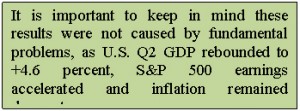Investors are confronting the possibility that nearly six years of a generally rising stock market have given way to a climate far less forgiving of complacency. Six days of roller coaster trading after October 8 almost completely erased the S&P index’s gains for the year which at last month were close to 9 percent. Another dose of worry and uncertainty was added as Ebola entered the United States for the first time. Even though the S&P index is up almost 200 percent since its closing low after the onset of the 2008 financial crisis, people still are still carrying scars from that daunting time period when practically every asset class fell in tandem.
When the news media reports the results of the stock market each day they tend to share how the Dow and S&P performed. It is important to keep in mind that this represents only US Large Cap holdings and only provides a glimpse of what is happening to the overall markets. This is especially pertinent as I recap recent market results.
What happened over the past quarter?
While year-to-date returns for most investors with diversified portfolios are still positive, many of these investors experienced negative returns for the third quarter. It’s certainly been a volatile period, as positive August results were sandwiched between declines in July and September. It is important to keep in mind these results were not caused by fundamental problems, as U.S. Q2 GDP rebounded to +4.6 percent, S&P 500 earnings accelerated and inflation remained dormant. The surprise factor was a sudden strengthening of the U.S. Dollar (USD), partly due to easing by international Central Banks and partly due to a “flight to quality” due to geopolitical concerns. During the third quarter, the USD staged one of its most powerful rallies in the past 25 years, gaining over 7 percent versus a basket of currencies.
Currencies, like interest rates, have proven very difficult to predict over time. While currencies may reflect general relative economic conditions to a degree, expected changes rarely show up as forecasted. By diversifying currencies globally, the overall impact of currency movements over time is smoothed out. However, a global diversification strategy can lead to short term underperformance versus a dollar basket as investors holding non-dollar denominated investments experienced this quarter.

To complicate currencies further, the European Central Bank (ECB), has indicated they may implement Quantitative Easing (QE). One result of QE is interest rate suppression, with the goal of faster economic growth. If investors expect QE to begin in Europe and finish in the U.S., global investors may be drawn to U.S. bonds–which currently provide higher yields than European bonds. This factor helps explain the USD strength vs. the Euro. In terms of international stocks, the Q3 return of 1.1 percent for the S&P 500 vs. -5.9 percent for MSCI EAFE and -3.5 percent for Emerging Markets was certainly abetted by USD strength. Nonetheless, inflows to international funds have remained strong all year.
Sharp pullbacks in nearly every major asset class, except large cap U.S. stocks, impacted most diversified portfolios for September. A significant divergence developed between U.S. large cap stocks and nearly every other major stock index in the world. Although the S&P 500 declined 1.4 percent for the month, it outperformed small and mid cap U.S. stocks by 3 percent-4 percent, international stocks by 4 percent-5 percent and commodities by 5 percent-6 percent. Most fixed income indexes also posted negative returns, with international bonds hardest hit. It’s always fascinating to see how often the best performer from the previous year becomes the worst performer the following year and vice versa. This is why a truly diversified portfolio is imperative!
Summary: Although investors who invested only in the S&P 500 would have beaten less risky diversified portfolios in Q3, I believe strategies should be based on a long-term global perspective. Historically, individuals with well diversified portfolios, who have remained invested in the financial markets through both good and difficult times, have been appropriately awarded. If your portfolio is well diversified and you stay committed to your long-term investment plan -you should be well-positioned to weather market volatility.
The opinions expressed in this article are those of David Rosell and should not be construed as specific investment advice. All information is believed to be from reliable sources, however, no representation is made to its completeness or accuracy. All economic and performance information is historical and not indicative of future results. David Rosell is President of Rosell Wealth Management in Bend. He is the author of Failure is Not an Option- Creating Certainty in the Uncertainty of Retirement. You may learn more about his book at www.DavidRosell.com or Amazon.com. Ask for David’s book at Barnes & Noble and in Bend at Newport Market, Cafe Sintra, Bluebird Coffee Shop and Powell’s Books in Portland.
Investment advisory services offered through Rosell Wealth Management, a State Registered Investment Advisor. Securities offered through ValMark Securities, Inc. Member FINRA, SIPC 130 Springside Drive, Ste 300 Akron, Ohio 44333-2431. 800 765-5201. Rosell Wealth Management is a separate entity from ValMark Securities.




